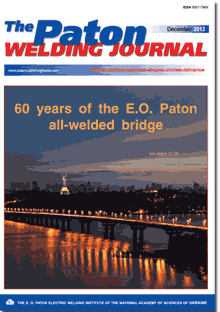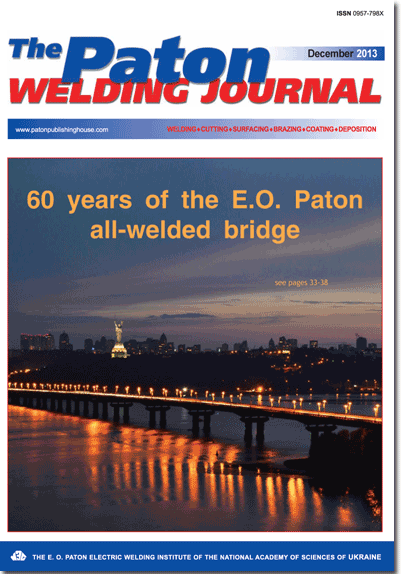| 2013 №12 (07) | 2013 №12 (09) |

The Paton Welding Journal, 2013, #12, 42-47 pages
METHODS OF GENERATION OF EXTERNAL MAGNETIC FIELDS FOR CONTROL OF ELECTROSLAG WELDING PROCESS
I.V. PROTOKOVILOV1, V.B. POROKHONKO1, A.T. NAZARCHUK1, Yu.P. IVOCHKIN2 and D.A. VINOGRADOV2
1E.O. Paton Electric Welding Institute, NASU. 11 Bozhenko Str., 03680, Kiev, Ukraine. E-mail: office@paton.kiev.ua
2Joint Institute for High Temperatures, RAS. 13 Izhorskaya Str., Build. 2, 125412, Moscow, Russia. E-mail: vortex@iht.mpei.ac.ru
Abstract
Efficiency of application of electromagnetic actions for control of joint formation during electroslag welding is determined in many respects by application of external magnetic fields to welding zone and structural peculiarities of corresponding devices. The aim of present work lied in analysis of methods for generation of external magnetic fields during electroslag welding of butt joints and evaluation of their effect on weld pool melt. The main methods of generation of longitudinal and transverse magnetic fields in a welding gap are considered, and principal schemes of corresponding electromagnetic devices are given. It is shown that direction and intensity of electromagnetic force effecting the weld pool melt is determined first of all by spatial orientation of the external magnetic field in relation to object being welded, value of field magnetic induction and its frequency characteristics. Rationality of application of that or another scheme of application of magnetic field in the gap depends on welded joint parameters, and it should be considered separately for each individual case. Appropriateness of application of magnetic fields providing constant (cyclic) rearrangement of hydrodynamic structure of flows in the weld pool or creating melt vibration was indicated. In this case, usage of pulsed magnetic fields generated by discharges of capacitor batteries to electromagnet coil is perspective. Relevance of development of new schemes and devices for generation of magnetic fields and their power sources is shown. 15 Ref., 9 Figures.
Keywords: electroslag welding, weld pool, magnetic field, hydrodynamics, electromagnetic action, devices for magnetic field application, magnetic induction, electromagnetic force
Received: 15.08.13
Published: 28.12.13
References
1. (1980) Electroslag welding and surfacing. Ed. by B.E. Paton. Moscow: Mashinostroenie.
2. Yushchenko, K.A., Lychko, I.I., Sushchuk-Slyusarenko, I.I. (1998) Effective techniques of electroslag welding and prospects for their application in welding production. In: Welding and Surf. Rev., Vol.12, Pt 2. Amsterdam: Harwood Acad. Publ.
3. Paton, B.E., Dudko, D.A., Palti, A.M. et al. (1999) Electroslag welding (prospects of development). Avtomatich. Svarka, 9, 4-6.
4. Kompan, Ya.Yu., Shcherbinin, E.V. (1989) Electroslag welding and melting with controllable MHD-processes. Moscow: Mashinostroenie.
5. Kuznetsov, V.D., Kozakov, N.K., Shalda, L.M. (1987) Magnetic control of electroslag process. Kiev: Vyshcha Shkola.
6. Dudko, D.A., Rublevsky, I.N. (1960) Electromagnetic stirring of slag and metal pools in electroslag process. Avtomatich. Svarka, 9, 12-16.
7. Trochun, I.P., Chernysh, V.P. (1965) Magnetic control of solidification in ESR. Svarochn. Proizvodstvo, 11, 3-5.
8. Protokovilov, I.V., Porokhonko, V.B. (2012) Control of formation of welded joints in ESW (Review). The Paton Welding J., 10, 49-54.
9. Kompan, Ya.Yu., Petrov, A.N., Sharamkin, V.I. (1978) Some peculiarities of electroslag welding in longitudinal-radial magnetic fields. Avtomatich. Svarka, 9, 39-43.
10. Porokhonko, V.B., Protokovilov, I.V., Petrov, D.A. (2012) Specifics of electroslag welding of titanium using electromagnetic methods effects. Visnyk Adm.Makarov NUK, 5, 170-176. http:// ev.nuos.edu.ua/ua
11. Volkov, G.G. (1975) Electroslag welding with application of alternative electromagnetic field. Montazh i Spets. Raboty v Stroitelstve, 8, 14-15.
12. Kazakov, N.K., Kuznetsov, V.D., Korab, N.G. (1981) Selection of magnetic field input method during electroslag welding. Vestnik KPI. SeriesMachineBuilding, Issue 18, 76-78.
13. Ryzhov, R.N., Kuznetsov, V.D. (2006) External electromagnetic effects in the processes of arc welding and surfacing (Review). The Paton Welding J., 10, 29-35.
14. Razmyshlyaev, A.D., Mironova, M.V., Yarmonov, S.V. (2013) Transverse magnetic field input devices for arc welding and surfacing processes (Review). Ibid., 1, 39-43.
15. Kompan, Ya.Yu., Nazarchuk, A.T., Protokovilov, I.V. et al. (2012) Possibilities of application of pulse electromagnetic effects in electroslag processes. Sovr. Elektrometallurgiya, 2, 8-13.
Suggested Citation
I.V. PROTOKOVILOV, V.B. POROKHONKO, A.T. NAZARCHUK, Yu.P. IVOCHKIN and D.A. VINOGRADOV (2013) METHODS OF GENERATION OF EXTERNAL MAGNETIC FIELDS FOR CONTROL OF ELECTROSLAG WELDING PROCESS. The Paton Welding J., 12, 42-47.The cost of subscription/purchase order journals or individual articles
| Journal/Currency | Annual Set | 1 issue printed |
1 issue |
one article |
| TPWJ/USD | 384 $ | 32 $ | 26 $ | 13 $ |
| TPWJ/EUR | 348 € | 29 € | 24 € | 12 € |
| TPWJ/UAH | 7200 UAH | 600 UAH | 600 UAH | 280 UAH |
| AS/UAH | 1800 UAH | 300 UAH | 300 UAH | 150 UAH |
| AS/USD | 192 $ | 32 $ | 26 $ | 13 $ |
| AS/EUR | 180 € | 30 € | 25 € | 12 € |
| SEM/UAH | 1200 UAH | 300 UAH | 300 UAH | 150 UAH |
| SEM/USD | 128 $ | 32 $ | 26 $ | 13 $ |
| SEM/EUR | 120 € | 30 € | 25 € | 12 € |
| TDNK/UAH | 1200 UAH | 300 UAH | 300 UAH | 150 UAH |
| TDNK/USD | 128 $ | 32 $ | 26 $ | 13 $ |
| TDNK/EUR | 120 € | 30 € | 25 € | 15 € |
AS = «Automatic Welding» - 6 issues per year;
TPWJ = «PATON WELDING JOURNAL» - 12 issues per year;
SEM = «Electrometallurgy Today» - 4 issues per year;
TDNK = «Technical Diagnostics and Non-Destructive Testing» - 4 issues per year.


